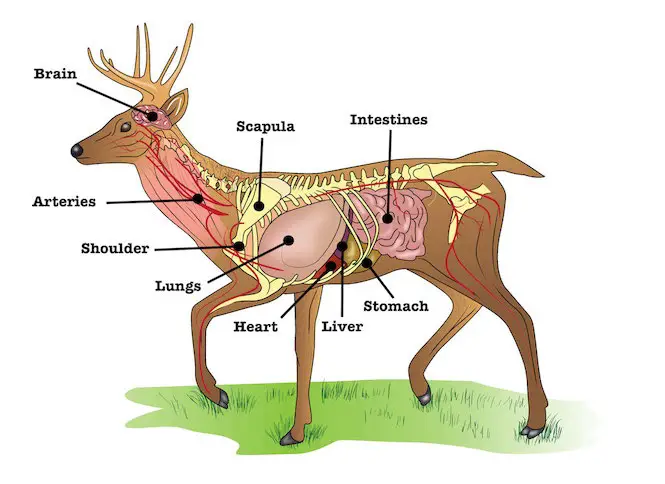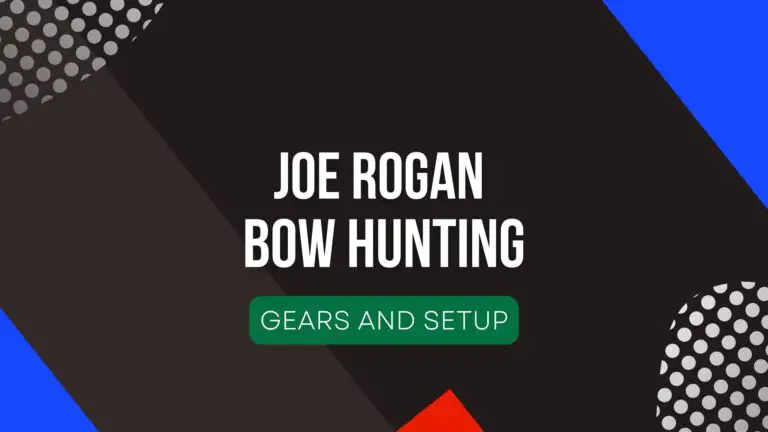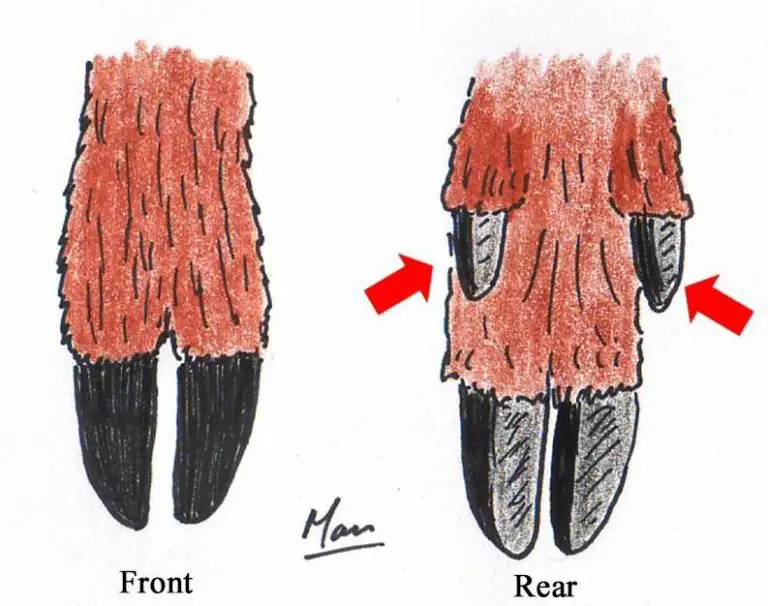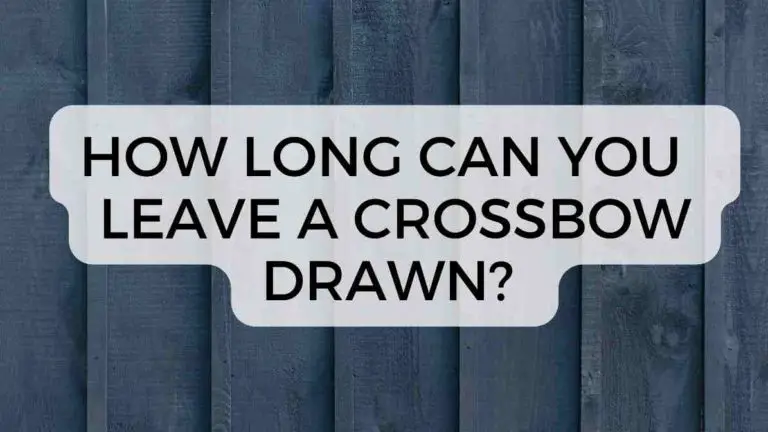Whitetail Deer Anatomy Guide: Where to Shoot?
Whitetail deer are one of the most popular game animals in the United States and worldwide. If you’re looking to hunt these amazing creatures, you need to be familiar with their anatomy.
Important: For a whitetail deer, the ideal shot placement with a bow is targeting the vitals, which are the heart and lungs in the chest cavity behind the shoulders. Aim directly in line with the front leg and between the halfway and lower one-third mark between the chest and back for a broadside shot. Knowing deer anatomy and hitting the vitals ensures ethical and effective hunting.
In this article, we’ll provide you with a comprehensive overview of whitetail deer anatomy, including key points about their body, head, antlers, legs, and more.
Also Recommended:
Where to shoot a deer?
When it comes to hunting deer, the definition of what constitutes an “ethical shot” has long been a point of contention. A shot that offers the quickest and most painless (and legal) kill should be used, regardless of your definition.
When hunting (particularly at long range), it’s simple for excitement to lead to poor shot selection. Unfortunately, this is a common occurrence, and the wounding of an animal causes needless pain.
On a deer, where is the kill zone? The anatomy of a deer may be found in the following places, and they must be properly performed to be effective.
-
The Heart Shot
A heart shot on a deer is simply deadly. Nevertheless, it does not always create the finest blood traces, despite the fact that it will cause a whitetail’s death. The flow of blood slows when the heart is hit, causing the blood trail to be less visible than you anticipated.
It is beneficial to ensure a quick recovery of the animal by piercing the lungs with a bullet or broadhead that hits the heart.
It’s important to ensure that the caliber of shot you’re using is adequate to penetrate the shoulder blade and cause a perfect kill when performing a heart shot. A bigger bullet may lead to more uneatable meat during processing, which is the downside.
-
The Lung Shot
Rifle and bowhunters alike can benefit from the lungs’ large target. Shooting a deer’s lungs with a broadhead will make it difficult for the animal to breathe, even if a bullet enters and exits its lungs.
After the shot, it’s usually unable to run far due to difficulty breathing. Poor blood trails may occasionally occur after simply clipping a lung or not obtaining a full pass-through shot, making the deer more difficult to track.
When it comes to lung shots with bows, they are just as effective as heart shots. Just shoot for the center of the lung region. The deer will die of suffocation after receiving a well-placed lung shot. A lung-shot effort that strikes too far back, on the other hand, might merely perforate the liver, resulting in a slower death and more difficult to monitor.
-
The Neck Shot
If the spinal cord is severed, you can kill a deer with one shot. A neck shot that cuts off the major arteries in the neck can be particularly severe and deadly.
However, if the spine is not severed, it may be difficult to recover and even survive after a fatal neck shot causes little damage to the animal’s flesh.
A neck shot with a gun might be a risky one, but it is almost never a good one when you’re a bowhunter.
-
The Brain Shot
A brain shot will instantly drop a deer if it is properly executed. The deer’s life functions will be disrupted and it will lose consciousness immediately after being shot in the brain with a bullet.
This shot is a difficult one to execute due to the small target area, but it results in no meat loss.
It’s possible that you won’t be able to recover the deer if the shot isn’t precise, and it’ll cause additional animal suffering.
whitetail deer anatomy
It’s also essential to be well-versed in the remainder of a whitetail’s anatomy so you may become a more rounded and knowledgeable hunter, even if we’ve gone over specific regions of it that may be targeted for during a hunt to procure a kill.

-
Digestive System
The four-chamber stomach of all deer species is present. Rumen, reticulum, omasum, and abomasum are the four chambers of the rumen. In a brief period of time, deer may consume enormous amounts of food. The rumen is the first stomach, which receives that food and passes it to the rumen.
The cellulose in the plant matter that the deer has eaten is beginning to be degraded by rumen digestive bacteria. The deer will regurgitate the food and chew it again because the rumen cannot completely break down and absorb all of the required nutrients. The deer “chewing its cud” is a common term for this. It allows the deer to break down the meal, even more, allowing it to absorb the nutrients it requires.
The food is sent to the reticulum, which acts as a strainer, after it has been chewed the second time. Foods that are difficult to digest will stay in the rumen and reticulum chambers for a longer time than foods that are easier to digest. While having a “full stomach,” this might cause a sort of roadblock and lead to malnutrition and occasionally death.
How long does it take for the food to pass from the reticulum to the omasum?
The food will move from the reticulum to the omasum after a roughly 16-hour period. Water from the food is absorbed in the omasum. The abomasum processes the food, eventually breaking it down further as a result of the acid produced.
The remainder of the food particles and liquid is delivered to the deer’s intestines, where they will eventually leave the body as feces and urine after leaving the abomasum. Whitetails normally defecate thirteen times each day.
-
Legs
It’s difficult to comprehend how a whitetail’s slender legs can generate so much speed and power at times.
Whitetail may run up to 40 miles per hour in brief spurts, despite the fact that they can’t maintain top speed for long periods.
They can make sharp turns and pivots, even at high speeds, thanks to the use of their hooves. Their speed and leaping ability are powered by their hind legs. Deer are excellent swimmers, to be precise.
Tarsal glands on the whitetail buck’s hind legs are visible on the inside. A musky perfume particular to that individual deer is secreted by these glands. In locations where it paws out on the ground, called scrapes, the buck will urinate on the glands and leave a scent.
These scrapes are checked for a scent by other males and female deer. Bucks will scent check scrape throughout the breeding season, also known as the “rut,” to find out who among the females in his area is or who among the intruders is in his vicinity.
-
Antlers
Antlers are part of the anatomy of male deer and grow on top of their head. A doe may grow antlers on rare occasions, although this is uncommon.
Antlers are made up of bone and live tissue in a whitetail deer. The fastest-growing tissue of all animals is found in a deer’s antlers. In the spring, whitetails begin growing their antlers, and they may grow at a pace of up to two inches each week!
The antlers are covered in velvet-like tissue during development. The blood vessels that develop antler growth are found in the velvet.
In late Summer and early Fall, antler growth usually slows. When the deer’s antlers stop growing, they rub the velvet against the trunks of trees to remove it.
Bucks will lose their antlers once the breeding season ends. Sheds may take place at any time of year but are most common between January and March.
-
Whitetail Ears And Hearing
Deers have considerably better hearing than humans. This helps a whitetail detect threats, such as people and other predators, from a distance.
The whitetail’s ears are Muscles that allow it to rotate and hear in multiple directions without having to move its head.
This allows it to estimate where the sound is coming from, as well as its distance. In order for a deer to survive, this section of its anatomy is critical.
-
Eyesight – All-Around Vision
A deer, on the other hand, has a 310-degree field of vision because its eyes are located on the sides of its head. You may have heard this expression that someone possesses “eyes in the back of their head.” Eyes are almost as good as they get in the rear of the head!
Deer’s superb vision helps them see clearly during the nighttime hours, even though it is difficult for them to focus on one thing.
-
Smell
One of the best defense mechanisms of a whitetail is its superb sense of smell. To keep its nose moist, a deer will lick it. It is able to “catch” odor particles blown by the wind and adhere to the deer’s nose because of this.
This has both a benefit to a deer’s survival and an important role in the mating process.
Through urine and separate scent glands, both male and female deer emit a fragrance. A buck can tell when a doe is ready to breed or an invader buck is in the area thanks to a whitetail’s superior sense of smell.




